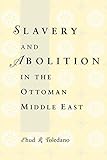Slavery and abolition in the Ottoman Middle East / Ehud R. Toledano.
Material type: TextSeries: Publications on the Near East, University of WashingtonPublication details: Seattle : University of Washington Press, c1998. Description: xii, 185 p. ; 23 cmISBN: 029597642X (pbk. : alk. paper)Other title: Slavery and abolitionUniform titles: Project Muse UPCC books Subject(s): Slavery -- Middle East -- History | Slave trade -- Middle East -- History | Slavery and Islam -- History | Turkey -- History -- Ottoman Empire, 1288-1918Genre/Form: HistoryDDC classification: 306.3/62/0956 LOC classification: HT1316 | .T65 1998
TextSeries: Publications on the Near East, University of WashingtonPublication details: Seattle : University of Washington Press, c1998. Description: xii, 185 p. ; 23 cmISBN: 029597642X (pbk. : alk. paper)Other title: Slavery and abolitionUniform titles: Project Muse UPCC books Subject(s): Slavery -- Middle East -- History | Slave trade -- Middle East -- History | Slavery and Islam -- History | Turkey -- History -- Ottoman Empire, 1288-1918Genre/Form: HistoryDDC classification: 306.3/62/0956 LOC classification: HT1316 | .T65 1998| Item type | Current library | Call number | Status | Date due | Barcode |
|---|---|---|---|---|---|
 Books
Books
|
The BIAA David H. French Library Shelf 62 - Reading Room | H2n TOLED 25685 | Not for loan | books*000000019850 |
Includes bibliographical references (p. 169-177) and index.
Ottoman slavery and the slave trade -- Kul/harem slavery : the men, the women, the eunuchs -- The other face of harem bondage : abuse and redress -- Agricultural slavery among Ottoman Circassians -- Slavery and abolition : the battle of images -- Discourses on Ottoman and Ottoman-Arab slavery -- Ottoman slavery in world slavery.
"In the Ottoman Empire, many members of the ruling elite were legally slaves of the sultan and therefore could, technically, be ordered to surrender their labor, their property, or their lives at any moment. Nevertheless, slavery provided a means of social mobility, conferring status and political power within the military, the bureaucracy, or the domestic household and formed an essential part of patronage networks. Ehud R. Toledano's exploration of slavery from the Ottoman viewpoint is based on extensive research in British, French, and Turkish archives and offers rich, original, and important insights into Ottoman life and thought. In an attempt to humanize the narrative and take it beyond the plane of numbers, tables and charts, Toledano examines the situations of individuals representing the principal realms of Ottoman slavery, female harem slaves, the sultan's military and civilian kuls, court and elite eunuchs, domestic slaves, Circassian agricaultural slaves, slave dealers, and slave owners. Slavery and Abolition in the Ottoman Middle East makes available new and significantly revised studies on nineteenth-century Middle Eastern slavery and suggests general approaches to the study of slavery in different cultures."
